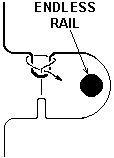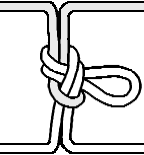 |
| Midspan Sheet Bend |
| As
the name suggests, the Midspan Sheet Bend allows the compact joining of
ropes away from, and without access to, the ends of the ropes by tying
them them together similar to the "landlubber" way to tie a Sheet Bend. Take the thicker* of the two ropes, if one exists, and shape it into a "U" shape. Take the other line and make a long bight (double-up the rope) and treat it like the end of a rope and form the "p" or "q" part of the sheet bend. If you did it right, you should have the ropes joined at midspan with a little loop at the knot from the bight of the smaller line you were treating like a single rope end. Now you can pull at any combination of the four ends of the rope. If you want to loop a rope without end-access onto a rail without end-access, you can again use the Midspan Sheet Bend to close off a loop around the endless rail, shown in the center diagram. However, since it's often better to hitch to an object if practical, you might just try doubling up the rope and treat it as the end of a rope to tie a timber hitch around the endless rail. Making a loop with a Midspan Sheet Bend is one way to expend excess rope on the bight. Since this actually makes two loops if you count the tiny one, a double loop knot can be made by expanding that tiny loop. _________________________________________________________________ *If the difference of diameter between the two ropes is too great, this knot will flip into a different form when the larger rope sees tension. If this happens, double up the smaller rope as shown for the Midspan Sheet Bend, but hitch it to the larger rope with a Sailor's Hitch instead, treating the larger rope as a passive object. Related Pages: Tumble Hitch, Pile Hitch, Timber Hitch on the Bight & Tumbling Timber Hitch |
 |
 |